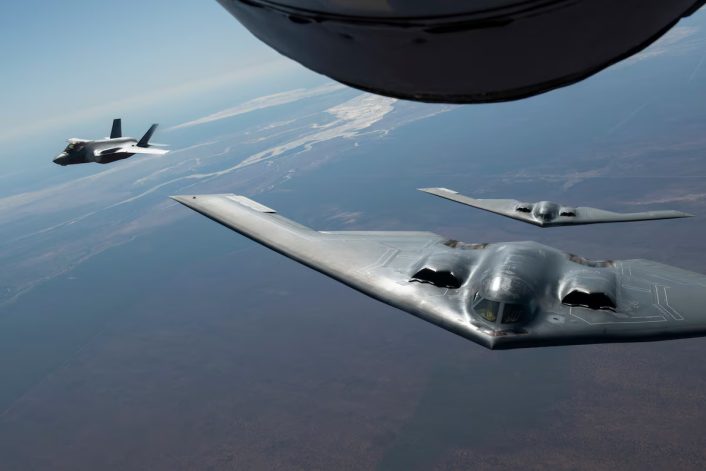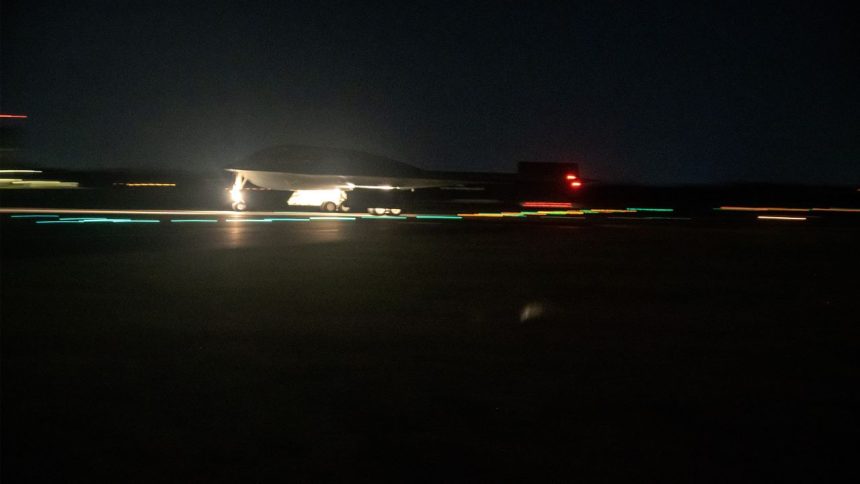The latest B-2 BTF deployment to Australia comes following diplomatic decisions between the two countries to increase US military presence there.
Two U.S. Air Force B-2 Spirit stealth bombers landed at RAAF (Royal Australian Air Force) Base Amberley on Aug. 16, 2024 as a part of a BTF (Bomber Task Force) mission. Videos released by the U.S. Air Force showed the two bombers landing at the base before being serviced by ground crew.
This is the first B-2 BTF mission to Australia after a two-year absence, with the last one being in 2022. The two bombers, “Spirit of Arizona” (82-1067) and “Spirit of Indiana” (82-1069), are assigned to the 509th and 131st Bomb Wings from Whiteman Air Force Base, Missouri.
“B-2 Spirit wheels have met pavement in Australia, launching the 2024 BTF mission and joint force integration with our Australian counterparts,” said the 509th Bomb Wing on X, while sharing the pictures of the B-2s’ arrival at RAAF Amberley.
B-2 Spirit wheels have met pavement in Australia, launching the 2024 BTF mission and joint force integration with our Australian counterparts.
📷 SSgt. Whitney Erhart#BomberTaskForce #BTF #bomber #Assurance #readiness@AFGlobalStrike | @PACAF | @AusAirForce | @usairforce pic.twitter.com/57kiotLYge
— 509th Bomb Wing (@Whiteman_AFB) August 17, 2024
Two KC-135R Stratotankers also arrived at the Australian base in support of the BTF mission. The tankers were shown during their arrival before the B-2 and were later visible at a distance on the same apron where the B-2s were parked.
“The U.S. maintains a strong, credible bomber force that enhances the security and stability of allies and partners,” said the caption of the videos. “BTF missions help to ensure a free and open Indo-Pacific region while providing prosperity and security for all.”
Journey to Australia
One of the B-2s (callsign CLONE11) made a position report with the San Francisco Radio over HF (High Frequency) radio as they crossed the equator, somewhere broadly over Kiribati and Tonga. It must be noted that this radio frequency is civilian and can be heard by anyone.
In fact, these frequencies are used during long range flights for position reports, clearance requests and other reports to intermediary stations which then report to the air traffic control. The reason for the use of HF radio is that the VHF (Very High Frequency) radios have a limited range and many areas such oceans can’t be covered by their signal.
CLONE11 (B-2 Stealth Bomber) making a position report with SAN FRANCISCO RADIO on HF as they cross the equator this evening. 😎💪 pic.twitter.com/9gTATrI2Ic
— Thenewarea51 (@thenewarea51) August 16, 2024
The video which showed the arrival of the KC-135 Stratotankers did specify that the tankers arrived on the same day of the bombers, so it could be assumed that they also supported the deployment flight. The aircraft, as they can be identified by their tail flashes and the serial number of the first (tail serial 91522), are part of the Illinois ANG (Air National Guard).
“United States strategic bombers can operate in the Indo-Pacific region from a broad array of overseas and continental U.S. locations with great operational resilience,” PACAF (Pacific Air Forces) said in a statement. “This deployment is in support of Pacific Air Forces’ training efforts with allies, partners, and joint forces and strategic deterrence missions to reinforce the rules-based international order.”
Increasing defense cooperation with Australia
In the previous BTF mission to Australia in Jul. 2022, two B-2s, also from the 509th BW arrived at the same RAAF base. At that time, they took part in Exercise Koolendong 22, “a combined and joint force exercise focused on expeditionary advanced base operations conducted by U.S. service members and Australian Defence Force personnel.” They were also shown flying alongside two RAAF F-35A Lightning IIs.
The latest deployment to Australia comes following diplomatic decisions between the two countries to increase US military presence in Australia. This is part of a raft of developments the two nations discussed during the U.S.-Australia Ministerial Consultations on Aug. 6, 2024.
“We’re …increasing the presence of rotational U.S. forces in Australia,” Secretary of Defense Lloyd J. Austin III said. “All this will mean more maritime patrol aircraft and reconnaissance aircraft operating from bases across northern Australia. It will also mean more frequent rotational bomber deployments.”
Earlier this year, Reuters suggested the Pentagon is constructing infrastructure in Australia to project power into the South China Sea. The report stated that documents for a U.S. military tender at RAAF Tindal include facilities to house six B-52 bombers and refueling aircraft.

ACE, DFE and BTF
As The Aviationist had reported in context of the recent first-of-its-kind F-22 deployment to Indonesia, explaining the DFE (Dynamic Force Employment) concept, the latest deployment to Australia of the B-2 can be seen as an application of DFE.
DFE’s key principle is to be operationally unpredictable in order to disrupt an adversary’s ability to respond and target allied forces. The U.S. Air Force describes DFE as the “ability to reach out from home station, fly anywhere in the world and execute those missions, rapidly regenerate from a forward operating base and continue operations.”
Also, earlier in August, the Airmen and DoD civilians from the 509th BW conducted a Field Training Exercise at Fort Smith in Arkansas on “ACE (Agile Combat Employment) concepts” after departing Whiteman AFB in a C-17 Globemaster III. It required “multi-capable airmen to step outside their regular career fields and operate independently in an expeditionary environment, making Air Force operations more difficult for adversaries to target while projecting airpower.”
Personnel practiced Rapid Airfield Damage Repair, land navigation, Tactical Combat Casualty Care, and base defense, that support ACE. “These skills enable Airmen to take on the challenge of building, maintaining, and defending a forward operating base in an austere environment which allows the Air Force to project airpower from anywhere.”
ACE, under whose scope falls the DFE, involves operating from austere airfields, large roads and highways with little supporting and technical infrastructure, dispersing assets out from the larger air bases that are likely to come under a sudden volume of Russian or Chinese tactical ballistic and cruise missiles. The strategy, while complicating adversary planning, also allows to hold adversary targets at risk from multiple locations.









